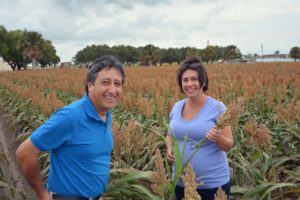Welasco, Texas, USA
October 23, 2014
The sugarcane aphid continues to spread throughout the South and is now considered the most important pest of grain sorghum in the U.S., according to Texas A&M AgriLife Extension Service experts.

Dr. Raul Villanueva, left, and Danielle Sekula-Ortiz will be among those hosting the AgriLife Extension field day on sugarcane aphids Oct. 28 in Weslaco. (AgriLife Communications photo by Rod Santa Ana)
“The sugarcane aphid has now reached 11 states in the South and several states in Mexico,” said Dr. Raul Villanueva, an AgriLife Extension entomologist. “This pest has spread much farther and faster than anyone had predicted.”
To help growers learn more about the situation and how to lower aphid populations going into the spring crop, AgriLife Extension will hold the Fall Sugarcane Aphid Field Day from 8:30-10:30 a.m. Oct. 28 at the Texas A&M AgriLife Research and Extension Center, 2415 E. U.S. Highway 83 in Weslaco.
The field day is free and open to the public. Registration begins at 8 a.m. Two Texas Department of Agriculture continuing education units will be available.
Sugarcane aphids reduce yields, but they also create abundant sticky waste called “honeydew” that can cause major problems and delays in harvest because it gums up harvest combines, Villanueva said.
“The 11 states now battling sugarcane aphids include Texas, Louisiana, Oklahoma, Mississippi, Alabama, Arkansas, Florida, Tennessee, Georgia, Kansas and South Carolina,” he said. “This is an invasive insect with sucking mouthpartsdetected in the U.S. in 2013 in South Texas with an appetite for grain sorghum instead of sugarcane.”
In 2014, it had affected grain sorghum fields in the Lower Rio Grande Valley to the point that many growers lost entire fields to the insect, he said. This year, yields in South Texas were not severely affected, but growers had additional expenses for insecticide sprays to control them.
In July, sugarcane aphids were identified for the first time west of U.S. Interstate 35. By September, they were confirmed on the southern High Plains of Texas and have since spread as far west as Florida.
“The sugarcane aphid is also present in Mexico,” Villanueva said. “It was detected in several states, including Tamaulipas, Nuevo Leon, Coahuila and in the west coast Mexican states of Sinaloa and Nayarit.”
In addition to Mexico, the sugarcane aphid can now overwinter in Florida, Villanueva said. From Florida, it could rapidly migrate to Georgia, South Carolina and even North Carolina, potentially creating a worse infestation than the current infestation.
“The good news is that the sugarcane aphid is a pest that was eventually managed in 2014 in the Rio Grande Valley and the Coastal Bend of Texas,” he said. “For 2015, growers may have more than one insecticide option to adequately control this insect. And it appears that there are sorghum varieties tolerant to this insect’s damage so growers could potentially have successful harvests next year.”
The key is education, some of which will be provided at the Oct. 28 field day, Villanueva said.
The first hour of the field day will include tours of grain sorghum research field plots where growers and the public can view results of insecticide efficacy tests and evaluate sorghum variety trials, according to Danielle Sekula-Ortiz, an AgriLife Extension integrated pest management agent in Weslaco.
“Presentations after the field tours will include discussion on our various chemical trials, including a new insecticide, plus our variety trials and an update on viruses transmitted by the sugarcane aphid,” she said. “It’s important that growers plan ahead and learn how to manage the sugarcane aphid so we can be better prepared for the 2015 growing season.”
For more information, contact Villanueva or Sekula-Ortiz at 956-968-5581 or the AgriLife Extension office in Hidalgo or Cameron counties.